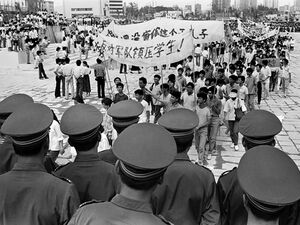Lushan Square Massacre
| Lushan Square Massacre | |
|---|---|
 Uniformed members of the BSP facing student demonstrators in the square | |
| Location | Lushan Square, Mirzak, Daxia |
| Date | 10 October 1995 5:00 PM |
| Target | National Strike Student Council |
Attack type | Government Repression |
| Deaths | 5000+ |
| Injured | 8500+ |
| Perpetrators | Daxia |
On October 10, 1995 in the Lushan Central Square of Mirzak, troops from the Daxian Armed Forces and BSP opened fire and killed thousands of student demonstrators. While the government struggled to destroy the Communist Party of Daxia and its armed wing, the emergence of a unified student protest movement was seen as a second front and existential threat that had to be contained at all costs. The Lushan Square Massacre alternatively called the Butchering of the Piglets and the 1995 Special Enforcement was a key event in the consolidation of power by the Party of Daxian Democrats, crushing the student protest movement and making it clear that peaceful opposition to the government would no longer be tolerated.
Background
The root of the conflict dates to the granting of broad administrative autonomy to the National University of Daxia(NUC) in 1986 by the NRF government. The granting of autonomy for the university was the product of a student led protest movement called the National Strike Council that organized demonstrations and walk outs that put pressure on the government. The university and student councils would then go on to become increasingly spaces of democratic debate that called for social, economic and political reform with varying degrees of success. The multiple social and economic grievances coupled with the lack of legitimacy that affected the NRF government meant that authorities were unwilling to violently suppress the student movement for fears of it spiraling into a widespread uprising. As the one party regime rotted out in slow motion, the issues championed by the students festered for the next few years.
The 1991 economic crisis propelled the Party of Daxian Democrats into power shortly after, with political leaders of said party echoing many of the demands that the student movement had championed a few years before. Once in power however, the new government moved speedily to consolidate its electoral mandate into control of all levers of power. In the fall of 1995 the Ministry of Education published a directive seriously curtailing the academic, administrative and budgetary independence of the National University. The National Strike Council quickly came out against these changes and called students and teachers to flood the streets of the capital. For five days, the streets of Mirzak were paralyzed by throngs of peaceful protesters calling on the government to reverse course. On October 8th, the Chancellor Linge Chen gave a menacing speech before the National Assembly, calling on protesters to stop behaving like hooligans and grasp the government's outstretched hand and negotiate. The National Strike Council denounced the speech as authoritarian and rejected to engage in negotiations 'under threat of repression'.
Massacre
On October 10th the National Strike Council called its biggest demonstration yet, calling on students to pack the central Republic Square in a show of strength. City authorities however blocked them with police barriers and slowly herded them towards the smaller Lushan Square. Unbeknownst to protesters, military units had been streaming into the capital since before Chen's speech on the 8th, with a decision to use force being reached possibly on the 6th. Unknown sources claimed that then BSP Director, Prib Dodd, privately justified the decision by stating that "the people crave order, they want fear back; the time for the bayonets has come".
BSP snipers were positioned on the roofs and upper floors of all the buildings around the square. As protesters began filling the square, pre-positioned army units under Colonel Bort Borg blocked all the three exits. At 9:00 pm the order was given to open fire on the students. The snipers began to fire first, killing dozens of people and sendng the crowd into a panic. As the students began running towards the eastern exit of the square they were ambushed and met with machine gun fire from the army units. By 9:15 the firing stopped and possibly thousands lay dead, the soldiers began entering the square and attacking the wounded with bayonets and detaining survivors that were somehow unharmed.
Remembrance
The day is not commemorated in Daxia due to the political sensitivity of the issue, small emigrant communities in the West do hold vigils every October 10 to commemorate the massacre.